University Name - System Thinking Analysis for Philips Report
VerifiedAdded on 2022/01/04
|18
|4019
|33
Report
AI Summary
This report presents a system thinking analysis of Philips, a company that faced significant challenges including financial crises, declining market share, and customer dissatisfaction. The analysis begins by identifying the problems, such as the emergence of competitors and loss of market share, and then applies the Soft System Methodology (SSM) to explore these issues. The report details the stages of SSM, including problem finding, expressing the problem situation, defining relevant systems using input-output diagrams and the CATWOE framework, deriving conceptual models, comparing these models with the real world, and analyzing feasible changes. Additional approaches, such as the rational approach, are also discussed. The report highlights critical aspects of applying SSM to Philips, emphasizing the need for product rationalization, improved customer satisfaction, and shorter development times. The analysis provides recommendations for immediate implementation, including centurion meetings, improved marketing, and ethical supplier relationships, offering a comprehensive overview of Philips' challenges and potential solutions.
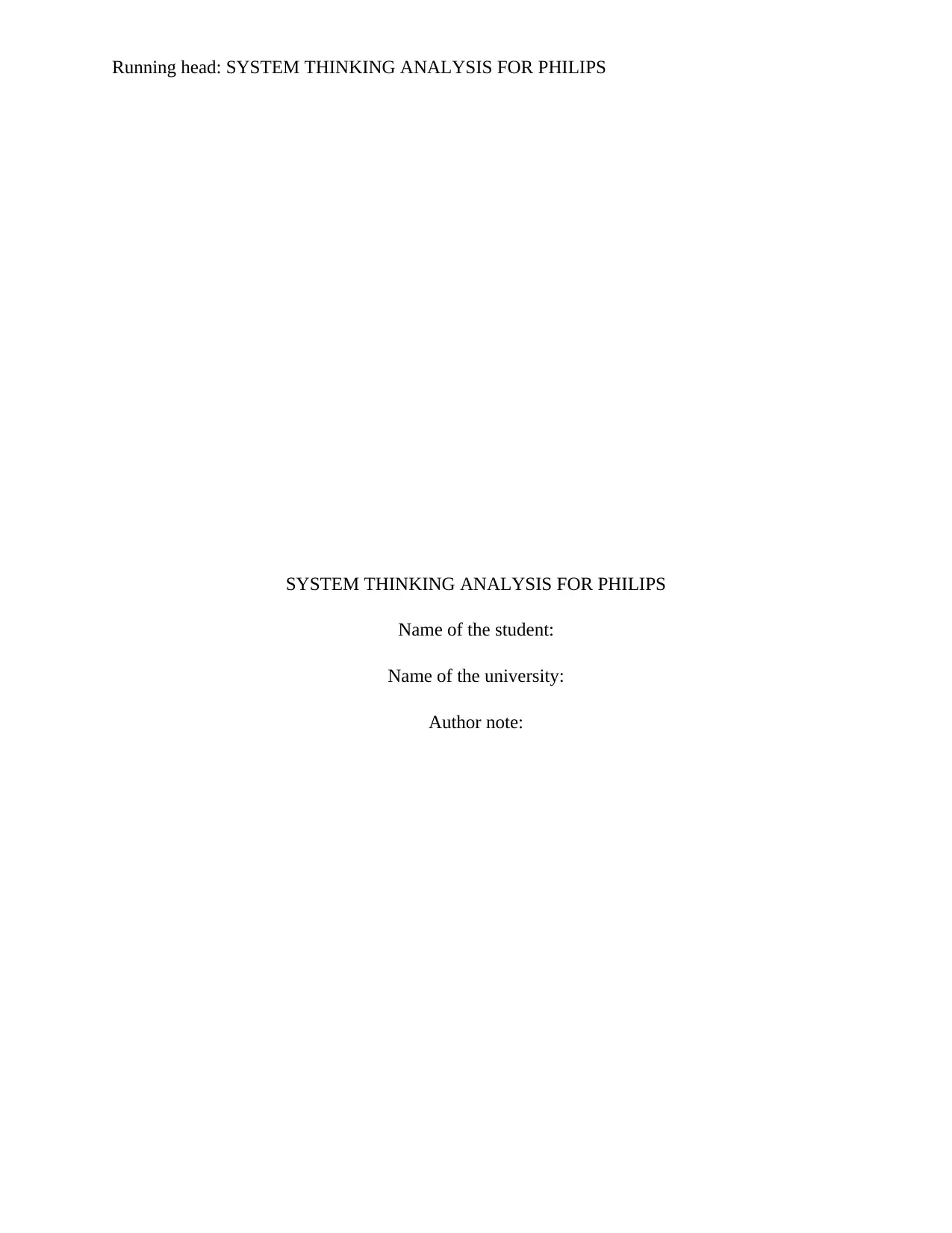
Running head: SYSTEM THINKING ANALYSIS FOR PHILIPS
SYSTEM THINKING ANALYSIS FOR PHILIPS
Name of the student:
Name of the university:
Author note:
SYSTEM THINKING ANALYSIS FOR PHILIPS
Name of the student:
Name of the university:
Author note:
Paraphrase This Document
Need a fresh take? Get an instant paraphrase of this document with our AI Paraphraser

1SYSTEM THINKING ANALYSIS FOR PHILIPS
Table of Contents
Answer 1: Implementation of soft system methodology within Philips:........................................2
Stage 1: Finding out the problem:...............................................................................................2
Stage 2: Expressing the problem situation for Philips:................................................................3
Stage 3: Defining the relevant systems:.......................................................................................4
Stage 4 Derivation of conceptual models for problem analysis:.................................................7
Stage 5 Comparison of conceptual model and the real world:....................................................8
Stage 6: Analyzing feasible changes and taking necessary actions:............................................9
Answer 2 Additional approaches and tools for problem analysis:................................................10
Rational approach:.....................................................................................................................10
Organic Approach:.....................................................................................................................11
Answer 3 Critical highlights from the application of SSM to Philips:..........................................11
Answer 4 Relevance of hard/soft technique for the problem analysis in Philips:.........................12
References:....................................................................................................................................14
Table of Contents
Answer 1: Implementation of soft system methodology within Philips:........................................2
Stage 1: Finding out the problem:...............................................................................................2
Stage 2: Expressing the problem situation for Philips:................................................................3
Stage 3: Defining the relevant systems:.......................................................................................4
Stage 4 Derivation of conceptual models for problem analysis:.................................................7
Stage 5 Comparison of conceptual model and the real world:....................................................8
Stage 6: Analyzing feasible changes and taking necessary actions:............................................9
Answer 2 Additional approaches and tools for problem analysis:................................................10
Rational approach:.....................................................................................................................10
Organic Approach:.....................................................................................................................11
Answer 3 Critical highlights from the application of SSM to Philips:..........................................11
Answer 4 Relevance of hard/soft technique for the problem analysis in Philips:.........................12
References:....................................................................................................................................14
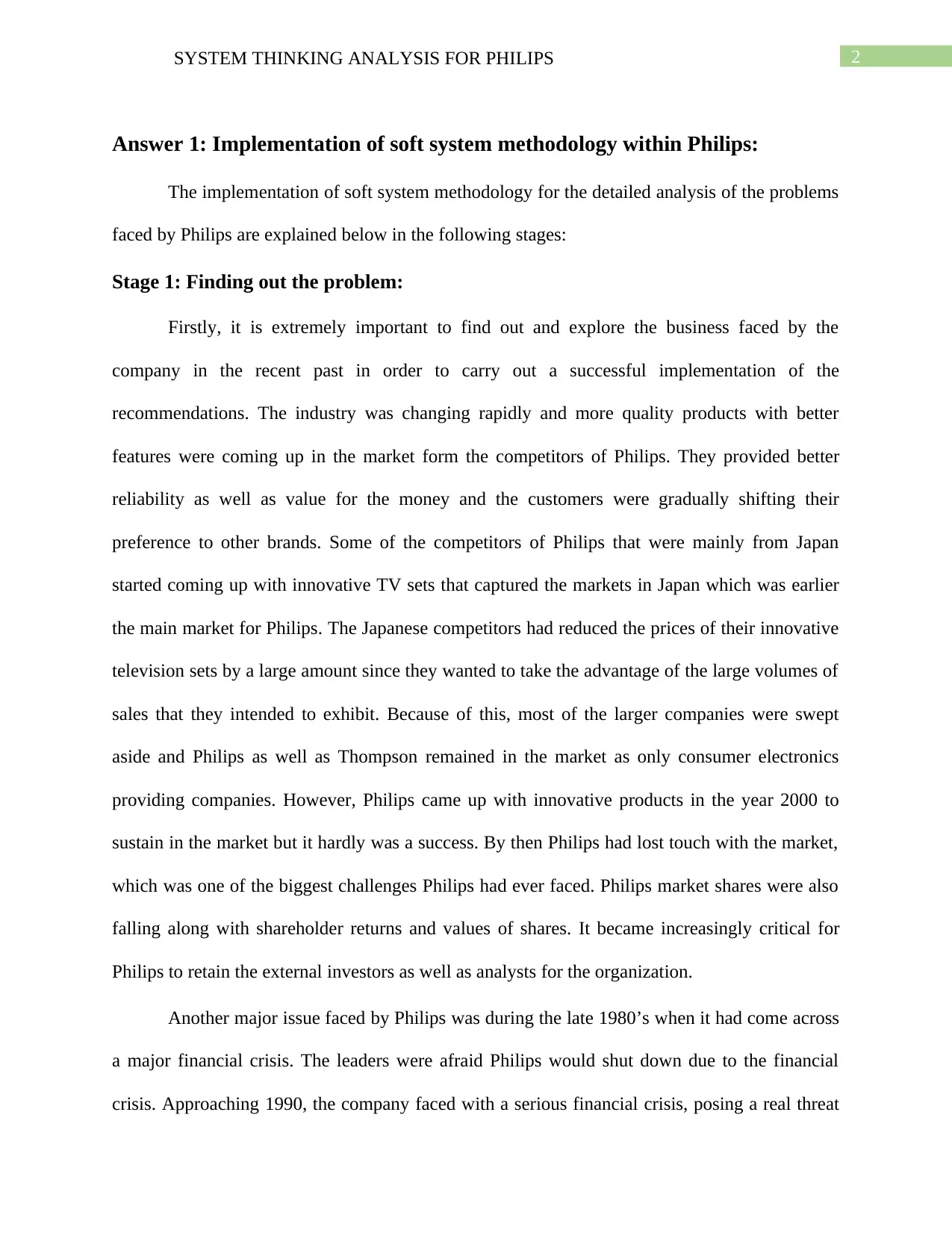
2SYSTEM THINKING ANALYSIS FOR PHILIPS
Answer 1: Implementation of soft system methodology within Philips:
The implementation of soft system methodology for the detailed analysis of the problems
faced by Philips are explained below in the following stages:
Stage 1: Finding out the problem:
Firstly, it is extremely important to find out and explore the business faced by the
company in the recent past in order to carry out a successful implementation of the
recommendations. The industry was changing rapidly and more quality products with better
features were coming up in the market form the competitors of Philips. They provided better
reliability as well as value for the money and the customers were gradually shifting their
preference to other brands. Some of the competitors of Philips that were mainly from Japan
started coming up with innovative TV sets that captured the markets in Japan which was earlier
the main market for Philips. The Japanese competitors had reduced the prices of their innovative
television sets by a large amount since they wanted to take the advantage of the large volumes of
sales that they intended to exhibit. Because of this, most of the larger companies were swept
aside and Philips as well as Thompson remained in the market as only consumer electronics
providing companies. However, Philips came up with innovative products in the year 2000 to
sustain in the market but it hardly was a success. By then Philips had lost touch with the market,
which was one of the biggest challenges Philips had ever faced. Philips market shares were also
falling along with shareholder returns and values of shares. It became increasingly critical for
Philips to retain the external investors as well as analysts for the organization.
Another major issue faced by Philips was during the late 1980’s when it had come across
a major financial crisis. The leaders were afraid Philips would shut down due to the financial
crisis. Approaching 1990, the company faced with a serious financial crisis, posing a real threat
Answer 1: Implementation of soft system methodology within Philips:
The implementation of soft system methodology for the detailed analysis of the problems
faced by Philips are explained below in the following stages:
Stage 1: Finding out the problem:
Firstly, it is extremely important to find out and explore the business faced by the
company in the recent past in order to carry out a successful implementation of the
recommendations. The industry was changing rapidly and more quality products with better
features were coming up in the market form the competitors of Philips. They provided better
reliability as well as value for the money and the customers were gradually shifting their
preference to other brands. Some of the competitors of Philips that were mainly from Japan
started coming up with innovative TV sets that captured the markets in Japan which was earlier
the main market for Philips. The Japanese competitors had reduced the prices of their innovative
television sets by a large amount since they wanted to take the advantage of the large volumes of
sales that they intended to exhibit. Because of this, most of the larger companies were swept
aside and Philips as well as Thompson remained in the market as only consumer electronics
providing companies. However, Philips came up with innovative products in the year 2000 to
sustain in the market but it hardly was a success. By then Philips had lost touch with the market,
which was one of the biggest challenges Philips had ever faced. Philips market shares were also
falling along with shareholder returns and values of shares. It became increasingly critical for
Philips to retain the external investors as well as analysts for the organization.
Another major issue faced by Philips was during the late 1980’s when it had come across
a major financial crisis. The leaders were afraid Philips would shut down due to the financial
crisis. Approaching 1990, the company faced with a serious financial crisis, posing a real threat
⊘ This is a preview!⊘
Do you want full access?
Subscribe today to unlock all pages.

Trusted by 1+ million students worldwide
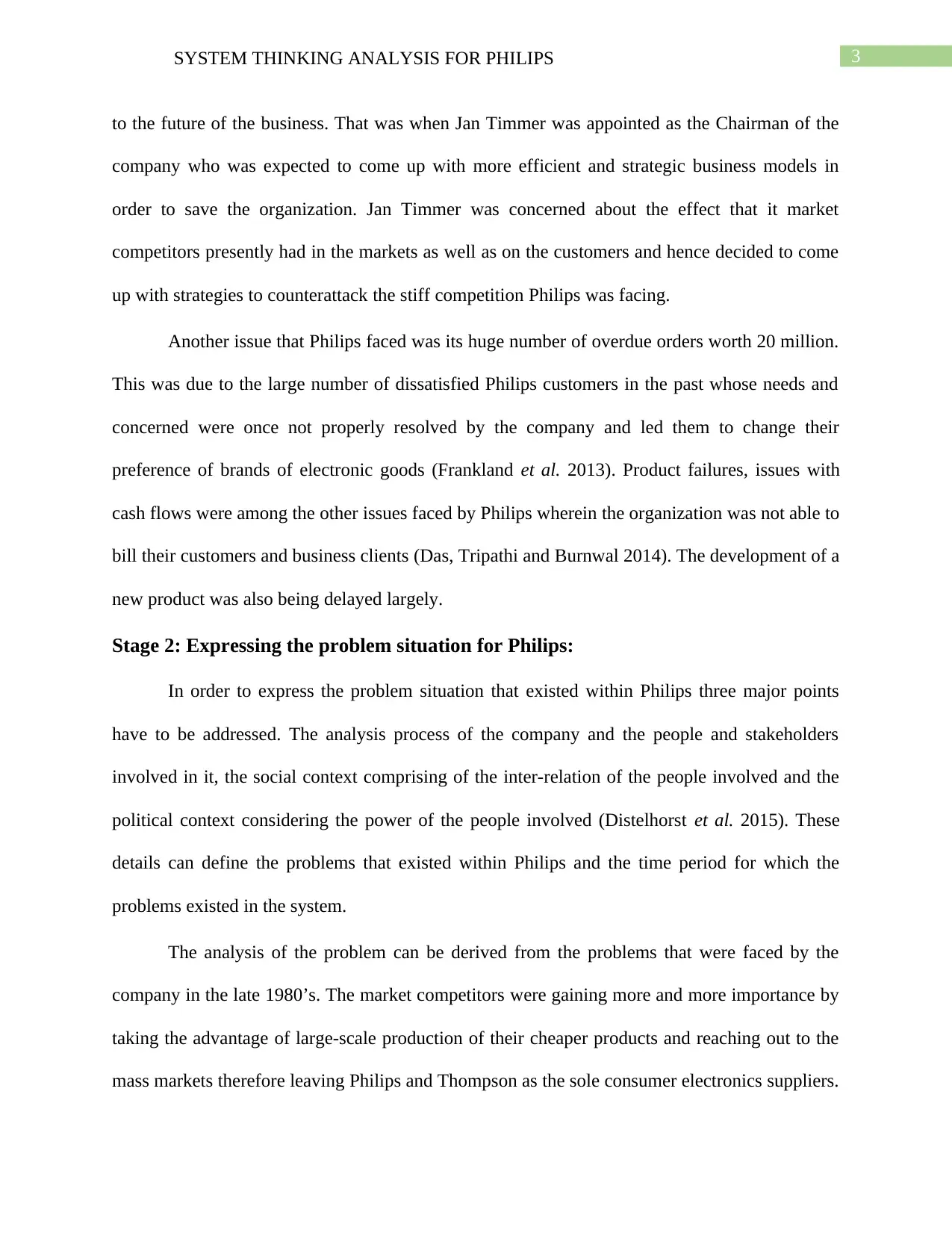
3SYSTEM THINKING ANALYSIS FOR PHILIPS
to the future of the business. That was when Jan Timmer was appointed as the Chairman of the
company who was expected to come up with more efficient and strategic business models in
order to save the organization. Jan Timmer was concerned about the effect that it market
competitors presently had in the markets as well as on the customers and hence decided to come
up with strategies to counterattack the stiff competition Philips was facing.
Another issue that Philips faced was its huge number of overdue orders worth 20 million.
This was due to the large number of dissatisfied Philips customers in the past whose needs and
concerned were once not properly resolved by the company and led them to change their
preference of brands of electronic goods (Frankland et al. 2013). Product failures, issues with
cash flows were among the other issues faced by Philips wherein the organization was not able to
bill their customers and business clients (Das, Tripathi and Burnwal 2014). The development of a
new product was also being delayed largely.
Stage 2: Expressing the problem situation for Philips:
In order to express the problem situation that existed within Philips three major points
have to be addressed. The analysis process of the company and the people and stakeholders
involved in it, the social context comprising of the inter-relation of the people involved and the
political context considering the power of the people involved (Distelhorst et al. 2015). These
details can define the problems that existed within Philips and the time period for which the
problems existed in the system.
The analysis of the problem can be derived from the problems that were faced by the
company in the late 1980’s. The market competitors were gaining more and more importance by
taking the advantage of large-scale production of their cheaper products and reaching out to the
mass markets therefore leaving Philips and Thompson as the sole consumer electronics suppliers.
to the future of the business. That was when Jan Timmer was appointed as the Chairman of the
company who was expected to come up with more efficient and strategic business models in
order to save the organization. Jan Timmer was concerned about the effect that it market
competitors presently had in the markets as well as on the customers and hence decided to come
up with strategies to counterattack the stiff competition Philips was facing.
Another issue that Philips faced was its huge number of overdue orders worth 20 million.
This was due to the large number of dissatisfied Philips customers in the past whose needs and
concerned were once not properly resolved by the company and led them to change their
preference of brands of electronic goods (Frankland et al. 2013). Product failures, issues with
cash flows were among the other issues faced by Philips wherein the organization was not able to
bill their customers and business clients (Das, Tripathi and Burnwal 2014). The development of a
new product was also being delayed largely.
Stage 2: Expressing the problem situation for Philips:
In order to express the problem situation that existed within Philips three major points
have to be addressed. The analysis process of the company and the people and stakeholders
involved in it, the social context comprising of the inter-relation of the people involved and the
political context considering the power of the people involved (Distelhorst et al. 2015). These
details can define the problems that existed within Philips and the time period for which the
problems existed in the system.
The analysis of the problem can be derived from the problems that were faced by the
company in the late 1980’s. The market competitors were gaining more and more importance by
taking the advantage of large-scale production of their cheaper products and reaching out to the
mass markets therefore leaving Philips and Thompson as the sole consumer electronics suppliers.
Paraphrase This Document
Need a fresh take? Get an instant paraphrase of this document with our AI Paraphraser

4SYSTEM THINKING ANALYSIS FOR PHILIPS
This resulted in more and more pressure on Philips to come up with innovative and reasonable
products for the customers at a time when the company was already at a financial crisis (Crane
and Matten 2016). Due to the increasing issues of the company, it had failed to provide attention
to the needs of the customers and that in turn caused them to be increasingly dissatisfied. The
different shareholders for the company such as government bodies taking care of the ethical
considerations of the electronics companies as well as customers were also losing their faith on
the company because of which it started facing more number of issues in the coming days (Abu-
Rub 2014). The shareholders also played an important role in the success and economy of the
company since they had stopped purchasing Philips shares seeing the degradation of the market
value of the company.
Stage 3: Defining the relevant systems:
The relevant systems that are needed to identify and reduce the problems that existed
within Philips can be depicted using the input output diagrams as explaining the elimination of
those problems using the CATWOE framework. It is important to understand that even the
computer systems that are needed to eliminate the organizational problems faced by Philips do
not just perform a single task but they perform a series of tasks comparable to human activities
(Checkland 2013). Therefore, a structured representation of the tasks expected out of the relevant
systems as well as the changes they are expected to bring within the organization can be shown
using the input output diagram and the CATWOE framework (Wong 2013), which makes use of
the following seven points for particular issues and their detailed analysis:
- Customers.
- Actors:
- Proposed change or transformation to resolve the issue.
This resulted in more and more pressure on Philips to come up with innovative and reasonable
products for the customers at a time when the company was already at a financial crisis (Crane
and Matten 2016). Due to the increasing issues of the company, it had failed to provide attention
to the needs of the customers and that in turn caused them to be increasingly dissatisfied. The
different shareholders for the company such as government bodies taking care of the ethical
considerations of the electronics companies as well as customers were also losing their faith on
the company because of which it started facing more number of issues in the coming days (Abu-
Rub 2014). The shareholders also played an important role in the success and economy of the
company since they had stopped purchasing Philips shares seeing the degradation of the market
value of the company.
Stage 3: Defining the relevant systems:
The relevant systems that are needed to identify and reduce the problems that existed
within Philips can be depicted using the input output diagrams as explaining the elimination of
those problems using the CATWOE framework. It is important to understand that even the
computer systems that are needed to eliminate the organizational problems faced by Philips do
not just perform a single task but they perform a series of tasks comparable to human activities
(Checkland 2013). Therefore, a structured representation of the tasks expected out of the relevant
systems as well as the changes they are expected to bring within the organization can be shown
using the input output diagram and the CATWOE framework (Wong 2013), which makes use of
the following seven points for particular issues and their detailed analysis:
- Customers.
- Actors:
- Proposed change or transformation to resolve the issue.
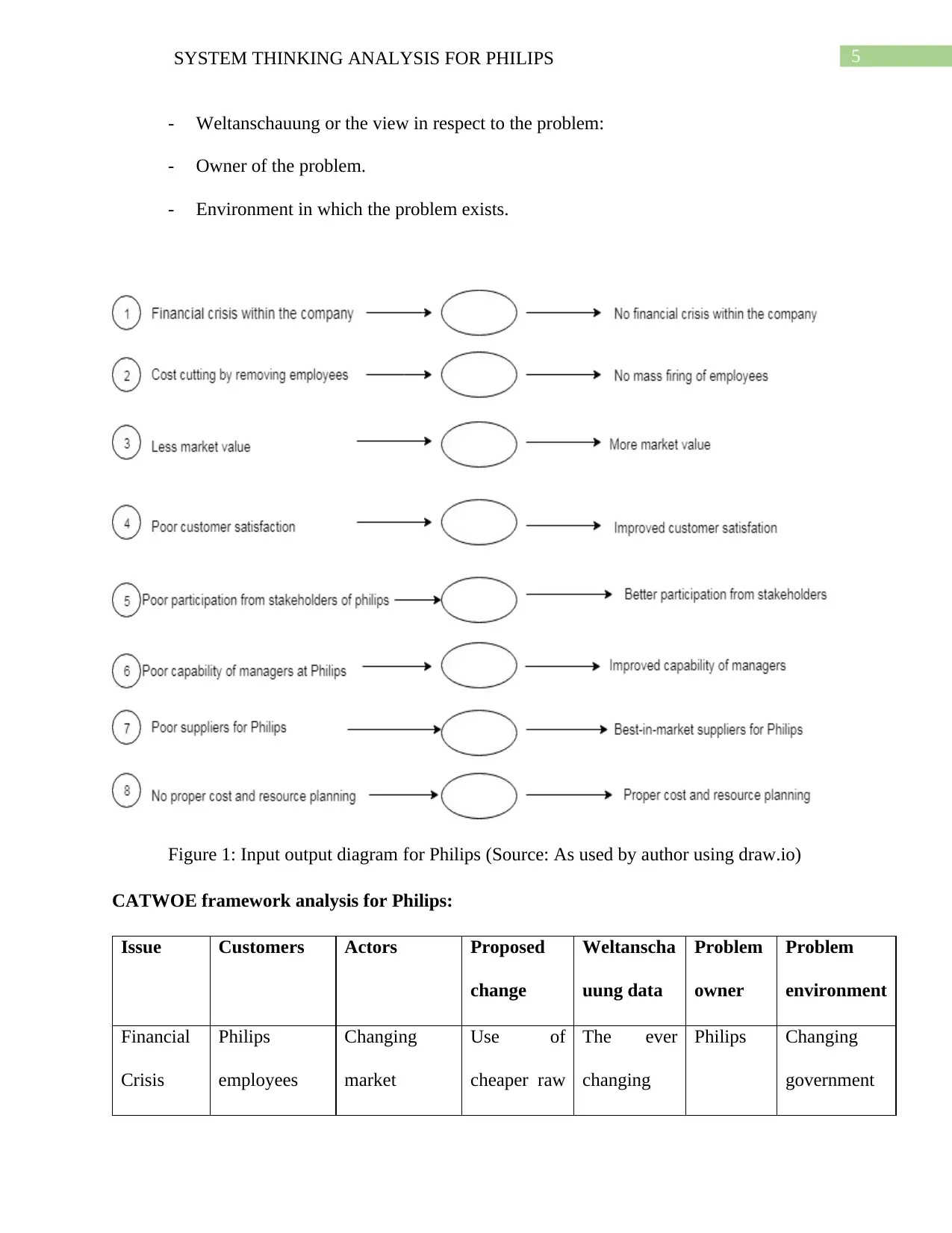
5SYSTEM THINKING ANALYSIS FOR PHILIPS
- Weltanschauung or the view in respect to the problem:
- Owner of the problem.
- Environment in which the problem exists.
Figure 1: Input output diagram for Philips (Source: As used by author using draw.io)
CATWOE framework analysis for Philips:
Issue Customers Actors Proposed
change
Weltanscha
uung data
Problem
owner
Problem
environment
Financial
Crisis
Philips
employees
Changing
market
Use of
cheaper raw
The ever
changing
Philips Changing
government
- Weltanschauung or the view in respect to the problem:
- Owner of the problem.
- Environment in which the problem exists.
Figure 1: Input output diagram for Philips (Source: As used by author using draw.io)
CATWOE framework analysis for Philips:
Issue Customers Actors Proposed
change
Weltanscha
uung data
Problem
owner
Problem
environment
Financial
Crisis
Philips
employees
Changing
market
Use of
cheaper raw
The ever
changing
Philips Changing
government
⊘ This is a preview!⊘
Do you want full access?
Subscribe today to unlock all pages.

Trusted by 1+ million students worldwide
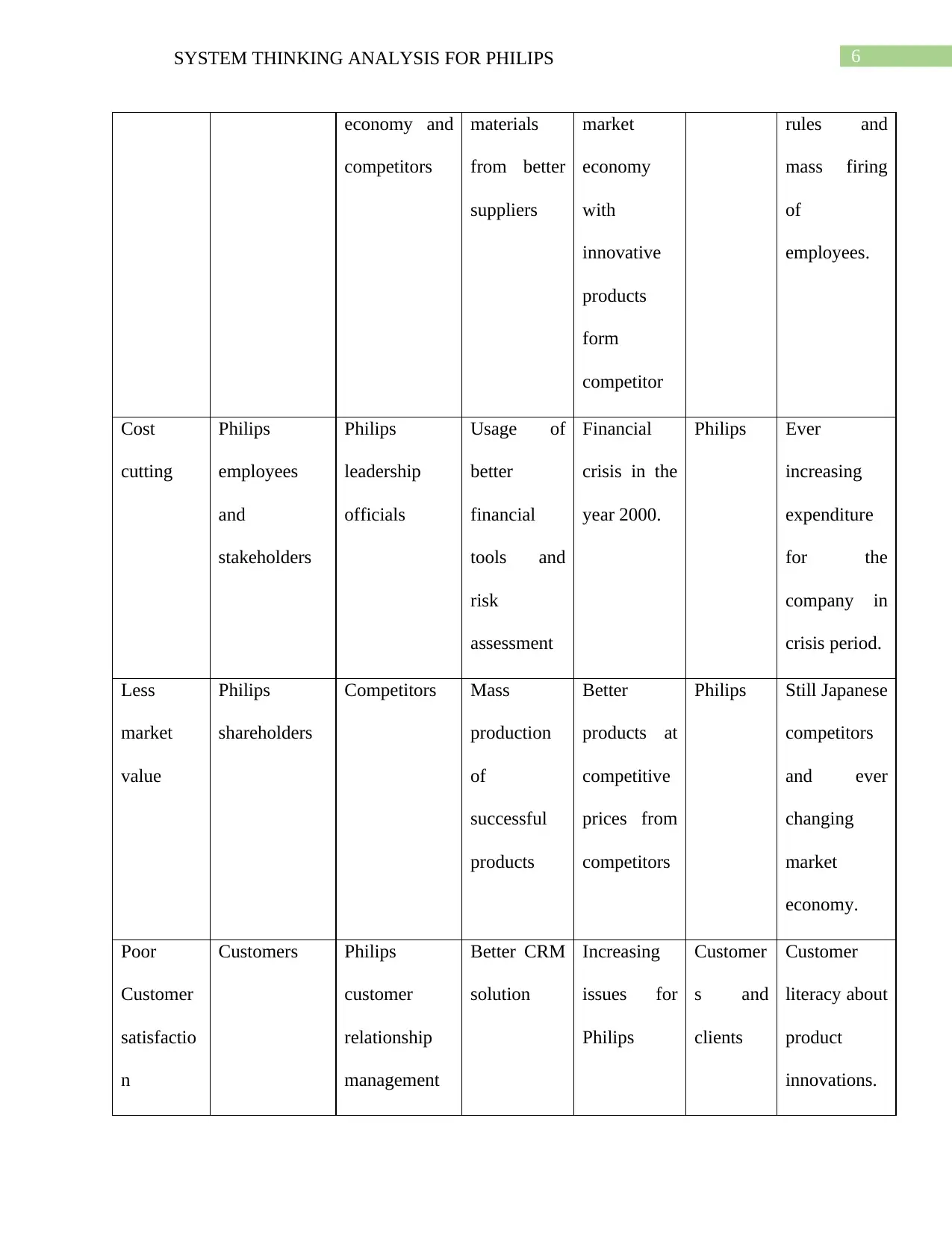
6SYSTEM THINKING ANALYSIS FOR PHILIPS
economy and
competitors
materials
from better
suppliers
market
economy
with
innovative
products
form
competitor
rules and
mass firing
of
employees.
Cost
cutting
Philips
employees
and
stakeholders
Philips
leadership
officials
Usage of
better
financial
tools and
risk
assessment
Financial
crisis in the
year 2000.
Philips Ever
increasing
expenditure
for the
company in
crisis period.
Less
market
value
Philips
shareholders
Competitors Mass
production
of
successful
products
Better
products at
competitive
prices from
competitors
Philips Still Japanese
competitors
and ever
changing
market
economy.
Poor
Customer
satisfactio
n
Customers Philips
customer
relationship
management
Better CRM
solution
Increasing
issues for
Philips
Customer
s and
clients
Customer
literacy about
product
innovations.
economy and
competitors
materials
from better
suppliers
market
economy
with
innovative
products
form
competitor
rules and
mass firing
of
employees.
Cost
cutting
Philips
employees
and
stakeholders
Philips
leadership
officials
Usage of
better
financial
tools and
risk
assessment
Financial
crisis in the
year 2000.
Philips Ever
increasing
expenditure
for the
company in
crisis period.
Less
market
value
Philips
shareholders
Competitors Mass
production
of
successful
products
Better
products at
competitive
prices from
competitors
Philips Still Japanese
competitors
and ever
changing
market
economy.
Poor
Customer
satisfactio
n
Customers Philips
customer
relationship
management
Better CRM
solution
Increasing
issues for
Philips
Customer
s and
clients
Customer
literacy about
product
innovations.
Paraphrase This Document
Need a fresh take? Get an instant paraphrase of this document with our AI Paraphraser
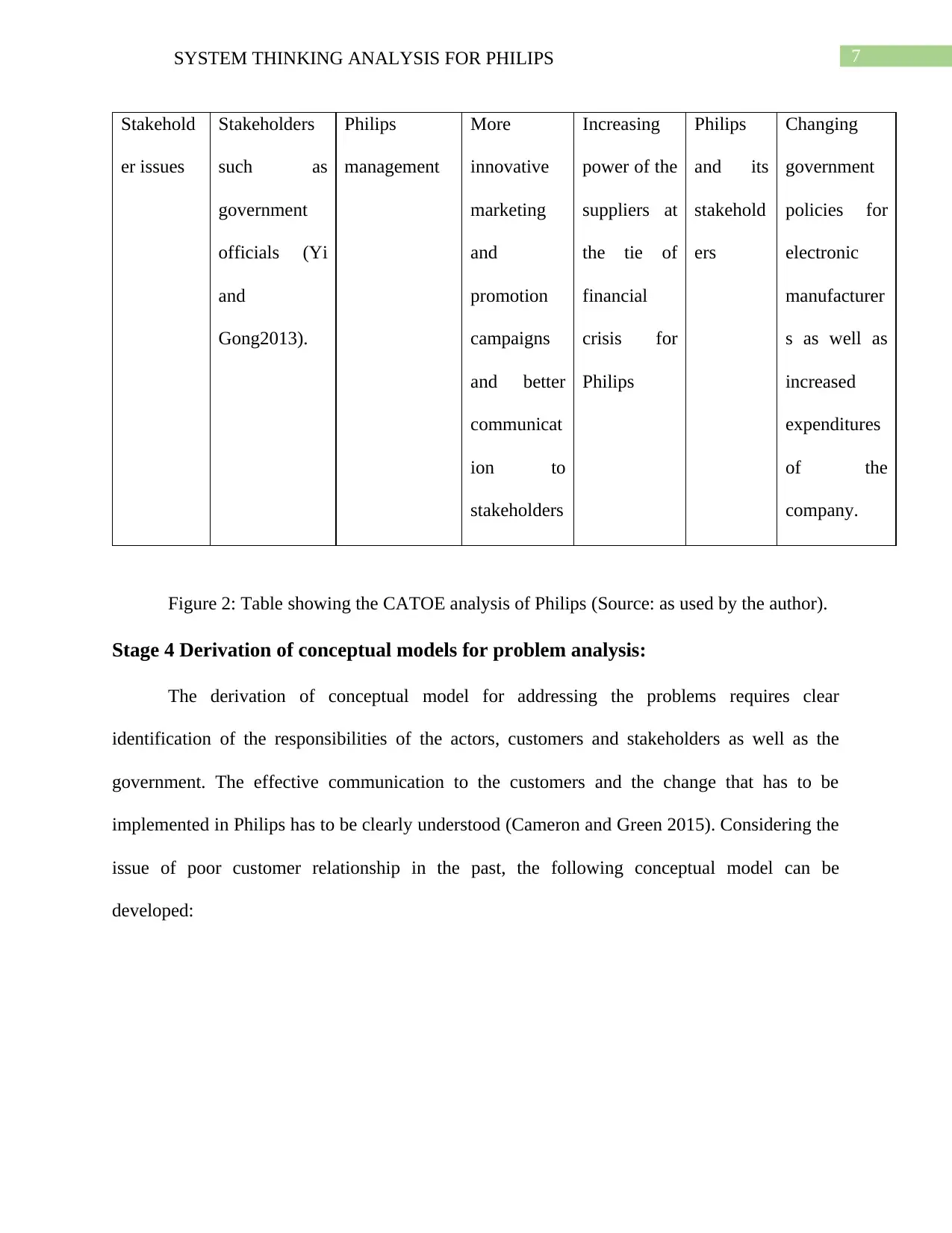
7SYSTEM THINKING ANALYSIS FOR PHILIPS
Stakehold
er issues
Stakeholders
such as
government
officials (Yi
and
Gong2013).
Philips
management
More
innovative
marketing
and
promotion
campaigns
and better
communicat
ion to
stakeholders
Increasing
power of the
suppliers at
the tie of
financial
crisis for
Philips
Philips
and its
stakehold
ers
Changing
government
policies for
electronic
manufacturer
s as well as
increased
expenditures
of the
company.
Figure 2: Table showing the CATOE analysis of Philips (Source: as used by the author).
Stage 4 Derivation of conceptual models for problem analysis:
The derivation of conceptual model for addressing the problems requires clear
identification of the responsibilities of the actors, customers and stakeholders as well as the
government. The effective communication to the customers and the change that has to be
implemented in Philips has to be clearly understood (Cameron and Green 2015). Considering the
issue of poor customer relationship in the past, the following conceptual model can be
developed:
Stakehold
er issues
Stakeholders
such as
government
officials (Yi
and
Gong2013).
Philips
management
More
innovative
marketing
and
promotion
campaigns
and better
communicat
ion to
stakeholders
Increasing
power of the
suppliers at
the tie of
financial
crisis for
Philips
Philips
and its
stakehold
ers
Changing
government
policies for
electronic
manufacturer
s as well as
increased
expenditures
of the
company.
Figure 2: Table showing the CATOE analysis of Philips (Source: as used by the author).
Stage 4 Derivation of conceptual models for problem analysis:
The derivation of conceptual model for addressing the problems requires clear
identification of the responsibilities of the actors, customers and stakeholders as well as the
government. The effective communication to the customers and the change that has to be
implemented in Philips has to be clearly understood (Cameron and Green 2015). Considering the
issue of poor customer relationship in the past, the following conceptual model can be
developed:
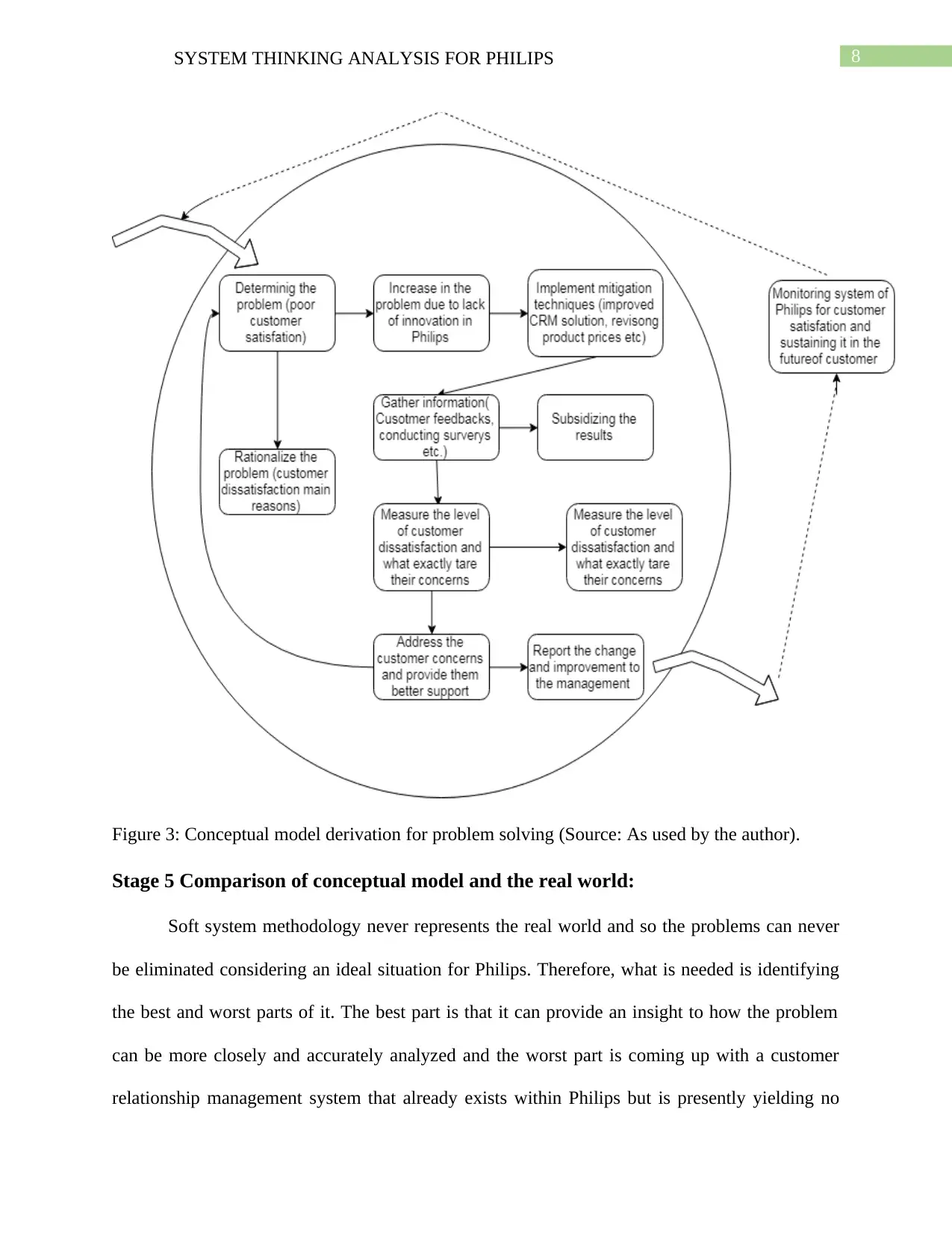
8SYSTEM THINKING ANALYSIS FOR PHILIPS
Figure 3: Conceptual model derivation for problem solving (Source: As used by the author).
Stage 5 Comparison of conceptual model and the real world:
Soft system methodology never represents the real world and so the problems can never
be eliminated considering an ideal situation for Philips. Therefore, what is needed is identifying
the best and worst parts of it. The best part is that it can provide an insight to how the problem
can be more closely and accurately analyzed and the worst part is coming up with a customer
relationship management system that already exists within Philips but is presently yielding no
Figure 3: Conceptual model derivation for problem solving (Source: As used by the author).
Stage 5 Comparison of conceptual model and the real world:
Soft system methodology never represents the real world and so the problems can never
be eliminated considering an ideal situation for Philips. Therefore, what is needed is identifying
the best and worst parts of it. The best part is that it can provide an insight to how the problem
can be more closely and accurately analyzed and the worst part is coming up with a customer
relationship management system that already exists within Philips but is presently yielding no
⊘ This is a preview!⊘
Do you want full access?
Subscribe today to unlock all pages.

Trusted by 1+ million students worldwide
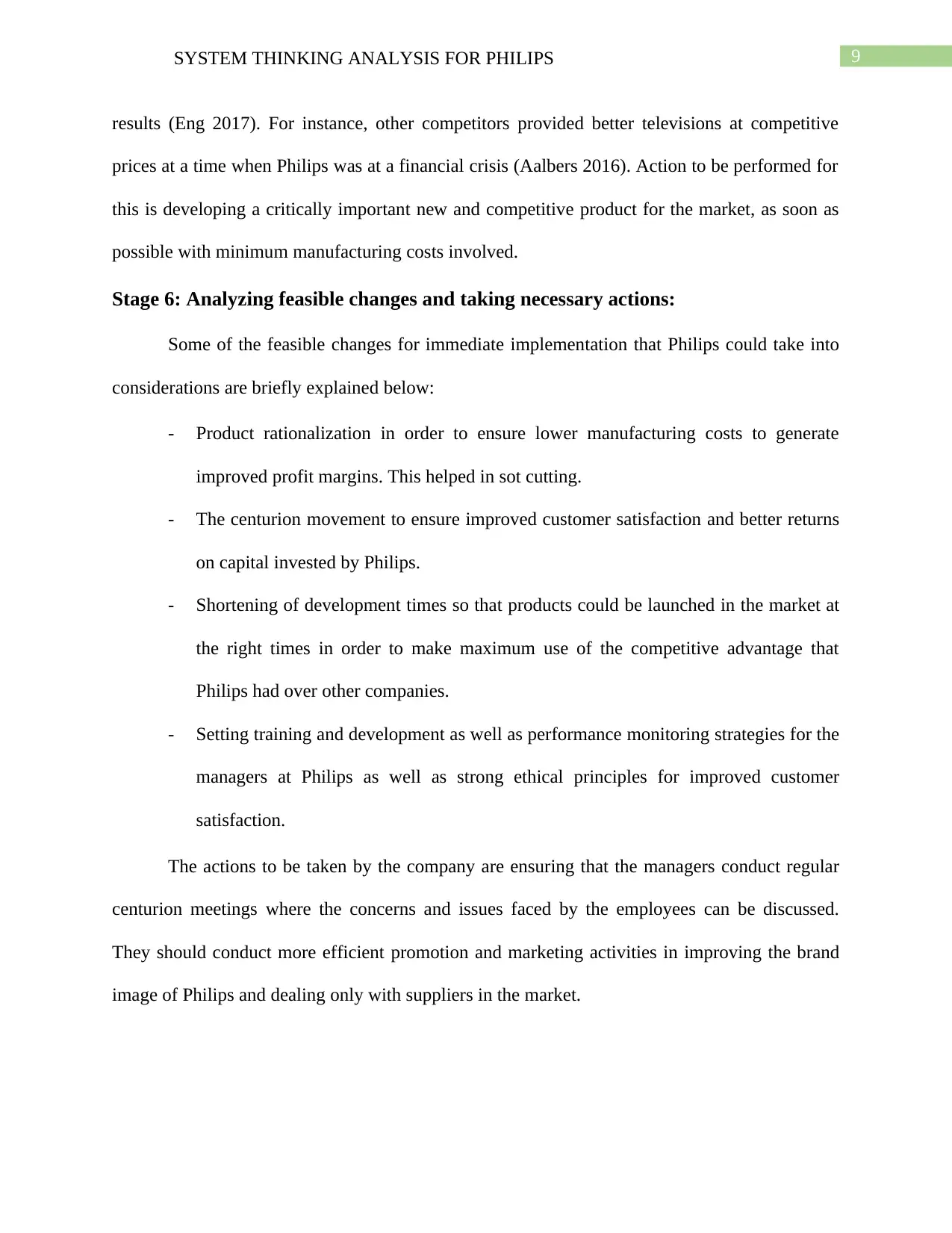
9SYSTEM THINKING ANALYSIS FOR PHILIPS
results (Eng 2017). For instance, other competitors provided better televisions at competitive
prices at a time when Philips was at a financial crisis (Aalbers 2016). Action to be performed for
this is developing a critically important new and competitive product for the market, as soon as
possible with minimum manufacturing costs involved.
Stage 6: Analyzing feasible changes and taking necessary actions:
Some of the feasible changes for immediate implementation that Philips could take into
considerations are briefly explained below:
- Product rationalization in order to ensure lower manufacturing costs to generate
improved profit margins. This helped in sot cutting.
- The centurion movement to ensure improved customer satisfaction and better returns
on capital invested by Philips.
- Shortening of development times so that products could be launched in the market at
the right times in order to make maximum use of the competitive advantage that
Philips had over other companies.
- Setting training and development as well as performance monitoring strategies for the
managers at Philips as well as strong ethical principles for improved customer
satisfaction.
The actions to be taken by the company are ensuring that the managers conduct regular
centurion meetings where the concerns and issues faced by the employees can be discussed.
They should conduct more efficient promotion and marketing activities in improving the brand
image of Philips and dealing only with suppliers in the market.
results (Eng 2017). For instance, other competitors provided better televisions at competitive
prices at a time when Philips was at a financial crisis (Aalbers 2016). Action to be performed for
this is developing a critically important new and competitive product for the market, as soon as
possible with minimum manufacturing costs involved.
Stage 6: Analyzing feasible changes and taking necessary actions:
Some of the feasible changes for immediate implementation that Philips could take into
considerations are briefly explained below:
- Product rationalization in order to ensure lower manufacturing costs to generate
improved profit margins. This helped in sot cutting.
- The centurion movement to ensure improved customer satisfaction and better returns
on capital invested by Philips.
- Shortening of development times so that products could be launched in the market at
the right times in order to make maximum use of the competitive advantage that
Philips had over other companies.
- Setting training and development as well as performance monitoring strategies for the
managers at Philips as well as strong ethical principles for improved customer
satisfaction.
The actions to be taken by the company are ensuring that the managers conduct regular
centurion meetings where the concerns and issues faced by the employees can be discussed.
They should conduct more efficient promotion and marketing activities in improving the brand
image of Philips and dealing only with suppliers in the market.
Paraphrase This Document
Need a fresh take? Get an instant paraphrase of this document with our AI Paraphraser
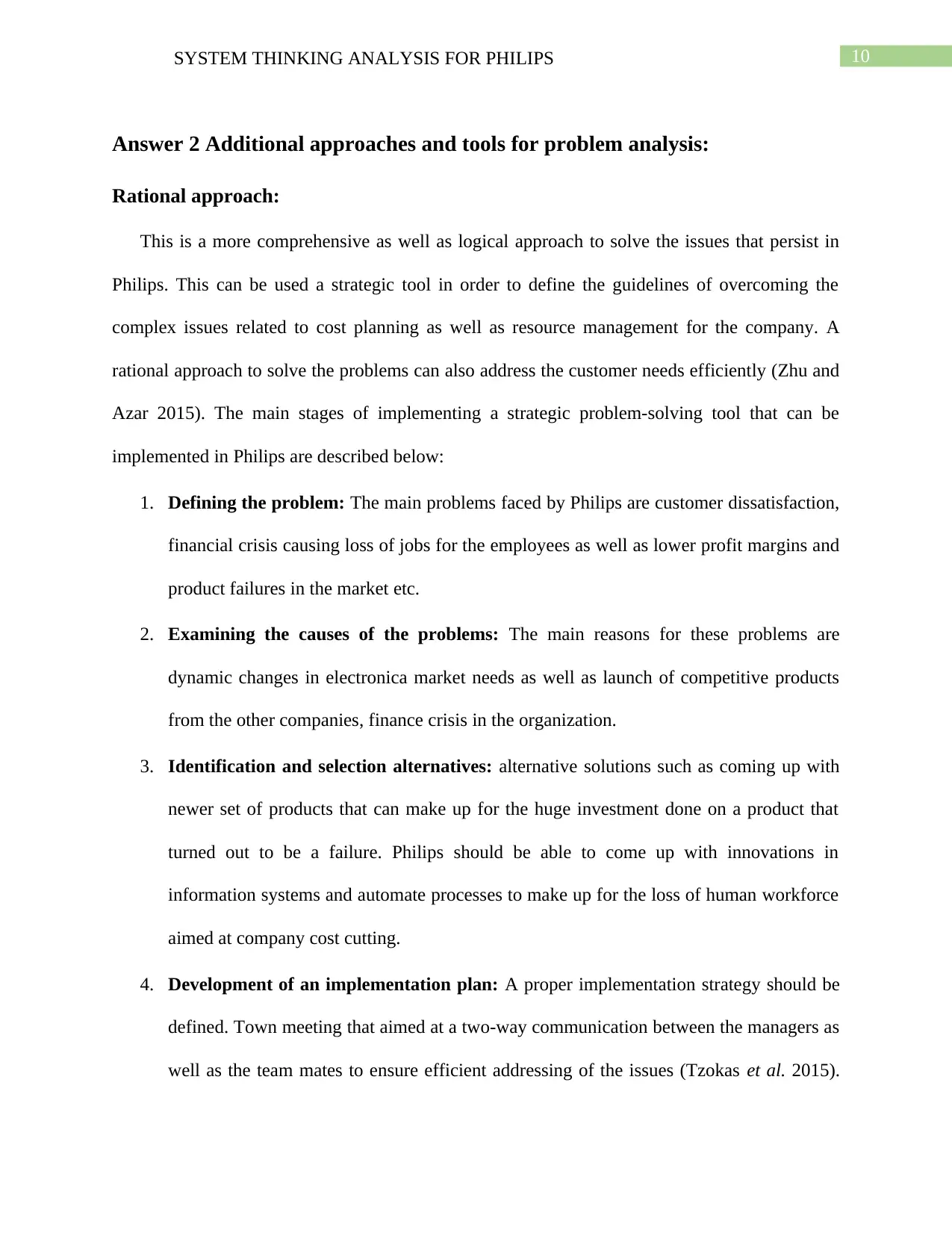
10SYSTEM THINKING ANALYSIS FOR PHILIPS
Answer 2 Additional approaches and tools for problem analysis:
Rational approach:
This is a more comprehensive as well as logical approach to solve the issues that persist in
Philips. This can be used a strategic tool in order to define the guidelines of overcoming the
complex issues related to cost planning as well as resource management for the company. A
rational approach to solve the problems can also address the customer needs efficiently (Zhu and
Azar 2015). The main stages of implementing a strategic problem-solving tool that can be
implemented in Philips are described below:
1. Defining the problem: The main problems faced by Philips are customer dissatisfaction,
financial crisis causing loss of jobs for the employees as well as lower profit margins and
product failures in the market etc.
2. Examining the causes of the problems: The main reasons for these problems are
dynamic changes in electronica market needs as well as launch of competitive products
from the other companies, finance crisis in the organization.
3. Identification and selection alternatives: alternative solutions such as coming up with
newer set of products that can make up for the huge investment done on a product that
turned out to be a failure. Philips should be able to come up with innovations in
information systems and automate processes to make up for the loss of human workforce
aimed at company cost cutting.
4. Development of an implementation plan: A proper implementation strategy should be
defined. Town meeting that aimed at a two-way communication between the managers as
well as the team mates to ensure efficient addressing of the issues (Tzokas et al. 2015).
Answer 2 Additional approaches and tools for problem analysis:
Rational approach:
This is a more comprehensive as well as logical approach to solve the issues that persist in
Philips. This can be used a strategic tool in order to define the guidelines of overcoming the
complex issues related to cost planning as well as resource management for the company. A
rational approach to solve the problems can also address the customer needs efficiently (Zhu and
Azar 2015). The main stages of implementing a strategic problem-solving tool that can be
implemented in Philips are described below:
1. Defining the problem: The main problems faced by Philips are customer dissatisfaction,
financial crisis causing loss of jobs for the employees as well as lower profit margins and
product failures in the market etc.
2. Examining the causes of the problems: The main reasons for these problems are
dynamic changes in electronica market needs as well as launch of competitive products
from the other companies, finance crisis in the organization.
3. Identification and selection alternatives: alternative solutions such as coming up with
newer set of products that can make up for the huge investment done on a product that
turned out to be a failure. Philips should be able to come up with innovations in
information systems and automate processes to make up for the loss of human workforce
aimed at company cost cutting.
4. Development of an implementation plan: A proper implementation strategy should be
defined. Town meeting that aimed at a two-way communication between the managers as
well as the team mates to ensure efficient addressing of the issues (Tzokas et al. 2015).
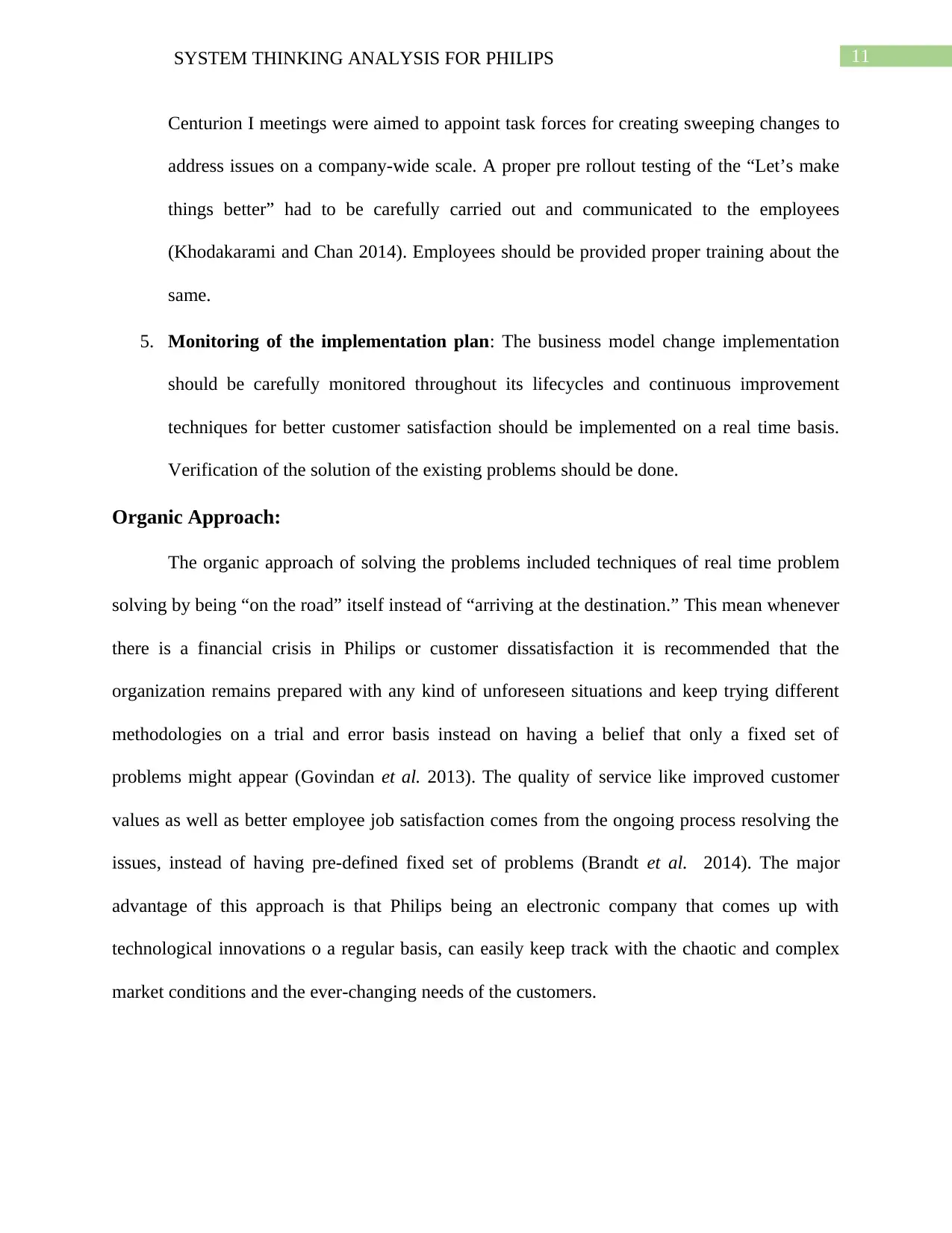
11SYSTEM THINKING ANALYSIS FOR PHILIPS
Centurion I meetings were aimed to appoint task forces for creating sweeping changes to
address issues on a company-wide scale. A proper pre rollout testing of the “Let’s make
things better” had to be carefully carried out and communicated to the employees
(Khodakarami and Chan 2014). Employees should be provided proper training about the
same.
5. Monitoring of the implementation plan: The business model change implementation
should be carefully monitored throughout its lifecycles and continuous improvement
techniques for better customer satisfaction should be implemented on a real time basis.
Verification of the solution of the existing problems should be done.
Organic Approach:
The organic approach of solving the problems included techniques of real time problem
solving by being “on the road” itself instead of “arriving at the destination.” This mean whenever
there is a financial crisis in Philips or customer dissatisfaction it is recommended that the
organization remains prepared with any kind of unforeseen situations and keep trying different
methodologies on a trial and error basis instead on having a belief that only a fixed set of
problems might appear (Govindan et al. 2013). The quality of service like improved customer
values as well as better employee job satisfaction comes from the ongoing process resolving the
issues, instead of having pre-defined fixed set of problems (Brandt et al. 2014). The major
advantage of this approach is that Philips being an electronic company that comes up with
technological innovations o a regular basis, can easily keep track with the chaotic and complex
market conditions and the ever-changing needs of the customers.
Centurion I meetings were aimed to appoint task forces for creating sweeping changes to
address issues on a company-wide scale. A proper pre rollout testing of the “Let’s make
things better” had to be carefully carried out and communicated to the employees
(Khodakarami and Chan 2014). Employees should be provided proper training about the
same.
5. Monitoring of the implementation plan: The business model change implementation
should be carefully monitored throughout its lifecycles and continuous improvement
techniques for better customer satisfaction should be implemented on a real time basis.
Verification of the solution of the existing problems should be done.
Organic Approach:
The organic approach of solving the problems included techniques of real time problem
solving by being “on the road” itself instead of “arriving at the destination.” This mean whenever
there is a financial crisis in Philips or customer dissatisfaction it is recommended that the
organization remains prepared with any kind of unforeseen situations and keep trying different
methodologies on a trial and error basis instead on having a belief that only a fixed set of
problems might appear (Govindan et al. 2013). The quality of service like improved customer
values as well as better employee job satisfaction comes from the ongoing process resolving the
issues, instead of having pre-defined fixed set of problems (Brandt et al. 2014). The major
advantage of this approach is that Philips being an electronic company that comes up with
technological innovations o a regular basis, can easily keep track with the chaotic and complex
market conditions and the ever-changing needs of the customers.
⊘ This is a preview!⊘
Do you want full access?
Subscribe today to unlock all pages.

Trusted by 1+ million students worldwide
1 out of 18
Related Documents
Your All-in-One AI-Powered Toolkit for Academic Success.
+13062052269
info@desklib.com
Available 24*7 on WhatsApp / Email
![[object Object]](/_next/static/media/star-bottom.7253800d.svg)
Unlock your academic potential
Copyright © 2020–2025 A2Z Services. All Rights Reserved. Developed and managed by ZUCOL.





